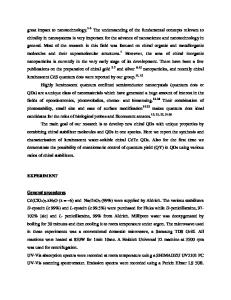Cyclodextrins Stabilize TOPO-(CdSe)ZnS Quantum Dots in Water
- PDF / 1,581,229 Bytes
- 5 Pages / 612 x 792 pts (letter) Page_size
- 74 Downloads / 294 Views
W4.5.1
Cyclodextrins Stabilize TOPO-(CdSe)ZnS Quantum Dots In Water Jun Feng, Yong-Hyun Kim‡, S. B. Zhang‡, Shi-You Ding, Melvin P. Tucker, Garry Rumbles, and Michael E. Himmel* Centers for National Bioenergy and Basic Science‡ National Renewable Energy Laboratory Golden, Colorado 80401 [email protected] Abstract: Chemical action between cyclodextrins (CDs) and TOPO-(CdSe)ZnS quantum dots (QDs) generates a water-soluble solution of CD-QDs. Hydrophobic TOPO molecules on surface of the QDs are compatible to thread through the pockets of CDs and make the hydroxyl group on end of CDs to approach the ZnS surface, and then cause the interaction between ZnS and the hydroxyls. In this paper, Photoluminescence of the γ-CD-QD solution appeared about 15 nm of red movement compared with that of the QDs in hexane; 58% replacement of the crystal coordinate bond of Zn-S with that of Zn-O in the ZnS shell was demonstrated by using first-principles density functional theory and the red shift of the photoluminescence of CD-QDs; and –0.11eV of the energy gain of the exchange model was calculated by using an effective mass (EM) model. CD-QDs will provide water-soluble QDs with conjugational group for biology and molecule-device applications. Keywords: Cyclodextrins, Quantum dots, Cyclodextrin-quantum dots, water-soluble To date, strategies for producing water-soluble quantum dots (QD) rely primarily on forming coordinate covalent bonds with thiol compounds [1-5] and polysilanes [6-7], which provide nucleophiles and other functionalized groups. Under certain conditions, biological molecules such as peptides, proteins, and DNA have the ability to interact with nanoparticles and QDs [8-16] and render them water-soluble. We report that trioctylphosphene oxide (TOPO)-(CdSe)ZnS QDs can be dispersed in water following interaction with cyclodextrins (CD), leaving the QDs photoluminescent. Cyclodextrins have ring structures with discrete dimensions. For example, the γ-CD is known to be 0.96-nm inner diameter, 1.69-nm maximum outer diameter, and 0.78-nm in thickness. The γ-CD has 24 hydroxyls on the outside, 8 on the A-side and 16 on the B-side. The dispersion of the TOPO-QDs in water by CDs can be attributed to the hydroxyl and water cluster effects [17], that make CDs a great “molecule adaptor”[18]. The inner lumen of the CD is hydrophobic and flexible, and we propose that this structure can accommodate the 8-carbon alkane chains of TOPO. (CdSe)ZnS QDs were synthesized following the method of Dabbousi and coworkers [19]. In hexane or toluene, these QDs are typically 3.4 to 3.6 nm in diameter and exhibit good photoluminescence (PL) quantum yields (PLQY > 15%) with little or no evidence of deep-trap emission associated with surface defects. The TOPO-QDs were purified by precipitation and centrifugation in anhydrous methanol. The precipitates were washed with anhydrous methanol to remove residual TOPO. Aliquots of 0.85 mg QDs in 0.1 mL hexane were slurried in 1.0 mL anhydrous ethanol and slowly pervaporated to remove the hexane. To produce CD
Data Loading...









